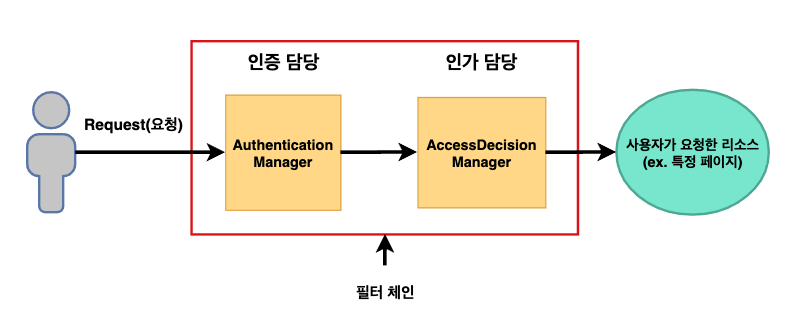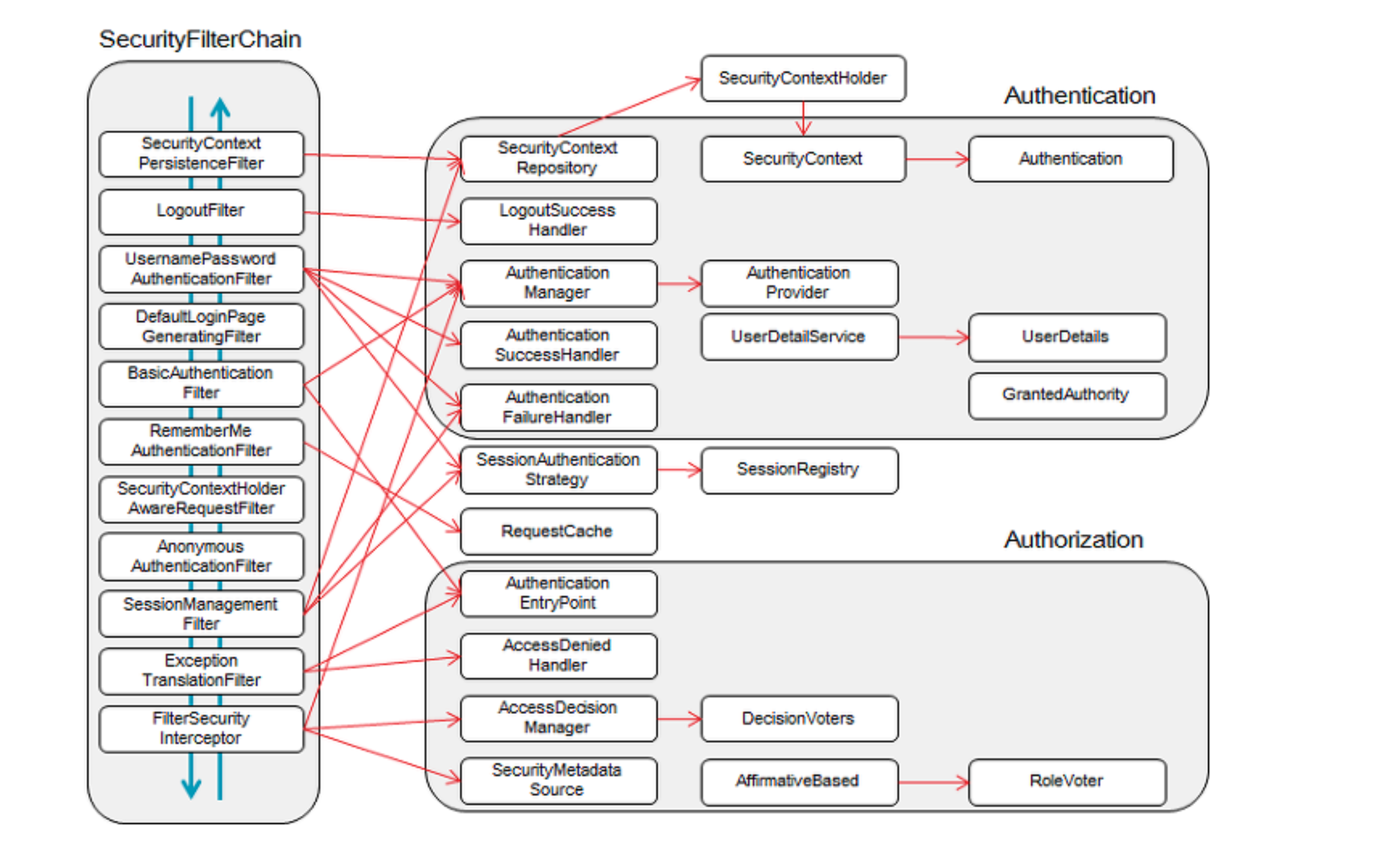Spring Security 인가
04 Jan 2021 | Spring Spring Security 인가 로그인Index
- Spring Security 인가
- Spring Security 인가과정
- AccessDecisionManager와 AccessDecisionVote
- AccessDecisionManager의 구현체
- AffirmativeBased
- ConsensusBased
- UnanimousBased
- WebSecurity 설정
- 정리
- References
Spring Security 인가

스프링 시큐리티 아키텍처를 매우 간략하게 그려본 그림이다.
스프링 시큐리티는 크게 인증과 인가 부분으로 나뉘며 인증 처리는 Authentication Manager 컴포넌트가, 인가 처리는 AccessDecision Manager라는 컴포넌트가 담당하여 처리한다. 그리고 이러한 인증과 인가 작업은 일련의 필터 체인을 통해 이루어진다.
여기서는 인증된 사용자가 요청한 리소스에 접근 가능한지 판단하는 인가 처리 과정에 대해 알아보자.
Spring Security 인가과정
Spring Security 필터 체인의 마지막 서블릿 필터는 FilterSecurityInterceptor 이다.
이 필터에서 해당 요청의 접근 여부를 결정하게 된다.
 출처 : https://atin.tistory.com/590
출처 : https://atin.tistory.com/590
인가 처리란 인증 처리가 선행된 후에 진행되는 과정으로, 인증이 완료된 사용자를 대상으로 한다. 인증이 끝나면 유저가 가진 권한 정보가 Authentication 객체에 담겨져 전달되는데, 이 권한 정보를 참조해서 해당 요청의 승인 여부를 결정하게 된다.
public interface Authentication extends Principal, Serializable {
// 유저가 가진 권한 목록이 저장되어 있다. ex ROLE_USER, ROLE_ADMIN
Collection<? extends GrantedAuthority> getAuthorities();
Object getCredentials();
Object getDetails();
Object getPrincipal();
boolean isAuthenticated();
void setAuthenticated(boolean var1) throws IllegalArgumentException;
}
인증 담당의 Authentication Manager와 마찬가지로 Access Decision Manager 또한 인터페이스이며, 실질적인 처리는 AccessDecisionManager의 구현체들이 수행한다!
AccessDecisionManager와 AccessDecisionVoter
인가 과정에서 AccessDecision Manager와 AccessDecision Voter라는 두 컴포넌트가 등장한다. 인과 과정은 우리가 의사결정을 위해 투표하는 방식과 매우 유사하다. 투표 방법은 여러가지가 있는데 그 중 만장일치와 과반수 그리고 한 명이라도 동의하는 경우 3가지가 있다. AccessDecisionManager은 이러한 결정 방법들을 구현체(알고리즘)로 제공해주고, voter들의 투표를 통해 접근 가능 여부를 판단한다. Voter는 투표 결과로 GRANTED(승인), ABSTAIN(보류), DENIED(거부) 3가지 중 하나를 선택 할 수 있다.
public interface AccessDecisionVoter<S> {
int ACCESS_GRANTED = 1;
int ACCESS_ABSTAIN = 0;
int ACCESS_DENIED = -1;
boolean supports(ConfigAttribute var1);
boolean supports(Class<?> var1);
/*
* 인자 정보: Authentication: 인증 정보, S (Object): 보호받는 자원(Url로 표현되는 리소스), Collection<ConfigAttribute>: 보호받는 자원과 관련된 설정들
* voter 구현체마다 구체적인 로직을 넣을 수 있고, 그 voter들을 Manager에 주입해서 사용하면 된다.
*/
int vote(Authentication var1, S var2, Collection<ConfigAttribute> var3);
}
public interface AccessDecisionManager {
void decide(Authentication var1, Object var2, Collection<ConfigAttribute> var3) throws AccessDeniedException, InsufficientAuthenticationException;
boolean supports(ConfigAttribute var1);
boolean supports(Class<?> var1);
}
좀더 자세히 알아보자.
- AccessDecisionManager 인터페이스는 컴포넌트는 2가지 메소드를 제공한다.
- supports
- AccessDecisionManager 구현체가 현재 요청을 지원하는지 여부를 판단하는 두개의 메소드를 제공한다.
- 하나는 java.lang.Class 타입을 파라미터로 받고 다른 하나는 ConfigAttribute 타입을 파라미터로 받는다.
- 인증 과정에서 ProviderManager의 supports 메소드 기능과 유사해 보인다.
- decide
- request context와 security configuration을 참조하여 접근 승인 여부를 결정한다. 리턴값은 없지만, 접근 거부를 의미하는 예외를 던져 요청이 거부되었음을 알려준다.
- 인증된 사용자의 리소스 접근 여부를 판단하는 3개의 기본 구현체를 제공한다
- AffirmativeBased: voter가 1개 이상 승인하면 접근 승인
- ConsensusBased: 과반수가 승인하면 요청 승인
- UnanimousBased: 모든 voter가 승인해야 요청 승인
- AccessDecisionManager는 다수의 AccessDecisionVoter로 구성된다.
- RoleVoter는 보호 리소스에 접근하기 위한 권한을 사용자가 지니고 있는지 확인한다.
AccessDecisionManager의 구현체
AffirmativeBased
public class AffirmativeBased extends AbstractAccessDecisionManager {
public AffirmativeBased(List<AccessDecisionVoter<?>> decisionVoters) {
super(decisionVoters);
}
public void decide(Authentication authentication, Object object, Collection<ConfigAttribute> configAttributes) throws AccessDeniedException {
int deny = 0;
Iterator var5 = this.getDecisionVoters().iterator();
while(var5.hasNext()) {
AccessDecisionVoter voter = (AccessDecisionVoter)var5.next();
int result = voter.vote(authentication, object, configAttributes); // voter가 투표한 결과
if (this.logger.isDebugEnabled()) {
this.logger.debug("Voter: " + voter + ", returned: " + result);
}
switch(result) {
case -1:
++deny;
break;
case 1:
return;
}
}
if (deny > 0) {
throw new AccessDeniedException(this.messages.getMessage("AbstractAccessDecisionManager.accessDenied", "Access is denied"));
} else {
this.checkAllowIfAllAbstainDecisions();
}
}
}
- 승인이 하나라도 있으면 종료하는 DecisionManager 구현체이다.
ConsensusBased
public class ConsensusBased extends AbstractAccessDecisionManager {
public ConsensusBased(List<AccessDecisionVoter<?>> decisionVoters) {
super(decisionVoters);
}
public void decide(Authentication authentication, Object object, Collection<ConfigAttribute> configAttributes) throws AccessDeniedException {
int grant = 0;
int deny = 0;
Iterator var6 = this.getDecisionVoters().iterator();
while(var6.hasNext()) {
AccessDecisionVoter voter = (AccessDecisionVoter)var6.next();
int result = voter.vote(authentication, object, configAttributes);
if (this.logger.isDebugEnabled()) {
this.logger.debug("Voter: " + voter + ", returned: " + result);
}
switch(result) {
case -1:
++deny;
break;
case 1:
++grant;
}
}
if (grant <= deny) {
if (deny > grant) {
throw new AccessDeniedException(this.messages.getMessage("AbstractAccessDecisionManager.accessDenied", "Access is denied"));
} else if (grant == deny && grant != 0) {
if (!this.allowIfEqualGrantedDeniedDecisions) {
throw new AccessDeniedException(this.messages.getMessage("AbstractAccessDecisionManager.accessDenied", "Access is denied"));
}
} else {
this.checkAllowIfAllAbstainDecisions();
}
}
}
public void setAllowIfEqualGrantedDeniedDecisions(boolean allowIfEqualGrantedDeniedDecisions) {
this.allowIfEqualGrantedDeniedDecisions = allowIfEqualGrantedDeniedDecisions;
}
}
- 승인이 과반수 이상일 때 종료되는 DecisionManager 구현체이다.
- grant(승인의 수)와 deny(거절의 수)를 기반으로 검증한다.
- 동점일 때의 처리는 allowIfEqualGrantedDeniedDecisions를 통해 정할 수가 있다.
UnanimousBased
public class UnanimousBased extends AbstractAccessDecisionManager {
public UnanimousBased(List<AccessDecisionVoter<?>> decisionVoters) {
super(decisionVoters);
}
public void decide(Authentication authentication, Object object, Collection<ConfigAttribute> attributes) throws AccessDeniedException {
int grant = 0;
List<ConfigAttribute> singleAttributeList = new ArrayList(1);
singleAttributeList.add((Object)null);
Iterator var6 = attributes.iterator();
while(var6.hasNext()) {
ConfigAttribute attribute = (ConfigAttribute)var6.next();
singleAttributeList.set(0, attribute);
Iterator var8 = this.getDecisionVoters().iterator();
while(var8.hasNext()) {
AccessDecisionVoter voter = (AccessDecisionVoter)var8.next();
int result = voter.vote(authentication, object, singleAttributeList);
if (this.logger.isDebugEnabled()) {
this.logger.debug("Voter: " + voter + ", returned: " + result);
}
switch(result) {
case -1:
throw new AccessDeniedException(this.messages.getMessage("AbstractAccessDecisionManager.accessDenied", "Access is denied"));
case 1:
++grant;
}
}
}
if (grant <= 0) {
this.checkAllowIfAllAbstainDecisions();
}
}
}
- 권한이 한 개도 없으면 실패하는 DecisionManager 구현체이다.
WebSecurity 설정
@Configuration
@EnableWebSecurity
public class WebSecurityConfigure extends WebSecurityConfigurerAdapter {
@Override
protected void configure(HttpSecurity http) throws Exception {
http
.csrf()
.disable()
.headers()
.disable()
.exceptionHandling() // 예외 핸들러 등록
.accessDeniedHandler(accessDeniedHandler) // accessDeniedHandler()는 권한 체크에서 실패할 때 수행되는 핸들러
.authenticationEntryPoint(unauthorizedHandler) // authenticationEntryPoint()는 인증되지 않은 사용자가 보호된 리소스에 접근했을 때 수행되는 핸들러
.and()
.sessionManagement()
.sessionCreationPolicy(SessionCreationPolicy.STATELESS)
.and()
.authorizeRequests() // URL별 권한 관리 설정
.antMatchers("/api/auth").permitAll()
.antMatchers("/api/user/join").permitAll()
.antMatchers("/api/**").hasRole(Role.USER.name())
.accessDecisionManager(accessDecisionManager()) // 사용할 accessDecisionManager 주입 (커스터마이징)
.anyRequest().permitAll()
.and()
.formLogin()
.disable();
http
.addFilterBefore(jwtAuthenticationTokenFilter(), UsernamePasswordAuthenticationFilter.class); // 사용자 정의 필터
}
}
- @EnableWebSecurity 어노테이션은 웹에서 시큐리티 기능을 사용하겠다는 어노테이션으로 부트에서는 관련 설정이 자동으로 적용된다.
- 자동 설정 그대로 사용할 수도 있지만, 요청, 권한, 기타 설정에 대해서는 필수적으로 최적화 설정이 필요하다. 이를 위해 WebSecurityConfigurerAdapter를 상속받고 configure 메소드를 오버라이드하여 원하는 형식의 시큐리티를 설정한다.
- configure() 메소드 설정 프로퍼티
- authorizeRequests()을 통해 URL별로 권한을 다르게 설정할 수가 있다.
- URL 패턴은 antMatchers()를 이용한다.
.authorizeRequests() // URL별 권한 관리 설정 .antMatchers("/api/auth").permitAll() .antMatchers("/api/user/join").permitAll() .antMatchers("/api/**").hasRole(Role.USER.name()) // WebExpressionVoter 구현체 통해 투표가 이뤄진다. .accessDecisionManager(accessDecisionManager()) // 사용할 accessDecisionManager 주입 (커스터마이징) .anyRequest().permitAll() - 위 코드에서 “/api”로 시작하는 요청 중 로그인/가입일 때는 제외하고, 모두 Role.User 권한을 갖고 있어야만 접근이 가능하다
.anyRequest().permitAll()- 위에서 설정한 요청(“/api”) 이외의 리퀘스트 요청은 모두 허가한다.
@Bean
public AccessDecisionManager accessDecisionManager() {
List<AccessDecisionVoter<?>> decisionVoters = new ArrayList<>();
decisionVoters.add(new WebExpressionVoter());
decisionVoters.add(connectionBasedVoter()); // 직접 구현한 voter
return new UnanimousBased(decisionVoters);
}
- 인가처리 커스터마이징
- 위 코드에서는 만장일치(UnanimousBased) 기반 AccessDecisionManager 구현체를 리턴하는 메서드이고, AccessDecisionManager는 Voter들의 리스트를 참조하고 있다.
- 우리가 직접 구현한 voter 객체를 사용하고 싶다면, 사용할 accessDecisionManager 구현체의 Voter 리스트에 넣어줘야 한다.
- 그 후
.accessDecisionManager(accessDecisionManager()처럼 사용할 manager 빈 객체를 accessDecisionManager()에 주입시켜준다.
- DecisionManager가 configure에 설정되어 있다면 FilterSecurityInterceptor 필터가 해당 DecisionManager를 호출해준다.
- DecisionManager를 따로 설정하지 않았다면, 디폴트로 AffirmativeBased(접근 승인 voter가 1개 이상) 기반의 Manager와 WebExpressionVoter의 voter 1개로 인가처리가 진행된다.
- WebExpressionVoter가 아까 configure()에 등록한 권한을 비교하여 투표한다
- DecisionManager는 N개의 Voter를 들고 있으며, 요청에 따른 Voter들의 투표결과에 따라 승인이 이뤄진다. 투표결과는 DecisionManager의 구현체에 따라 달라진다.
정리
-
인가 과정은 FilterSecurityInterceptor 필터에서 AccessDecision Manager와 Voter를 통해 이뤄진다. AccessDecisionManager는 AccessDecisionVoter 구현체들을 리스트로 들고 있으며, voter들의 투표 결과와 DecisionManager의 투표 정책에 따라 리소스 접근 여부가 결정된다.
-
설정 클래스에서 configure() 메소드를 오버라이딩해서 URL별 권한을 설정할 수 있다.
-
상황에 따라 Voter 구현체를 커스텀해서 사용할 수도 있다. 예를 들어 내가 올린 게시물을 본인과 친구만 볼 수 있게 하고 싶다면, 내 게시물에 대한 요청이 들어왔을 때, 요청한 주체가 게시물에 접근 권한이 있는지 확인해야 한다. 이때 특정 API 패턴(ex.게시물 조회 api)에 대해서만 확인을 하는 voter를 만든 후 Manager에 주입해주면 된다.
이전 포스트들을 통해서 지금까지 우리는 스프링 시큐리티의 동작원리 그리고 핵심 개념인 인증과 인가 처리 프로세스에 대해 알아 보았다.
인증이란 유저의 신원을 확인하는 과정이며 인가란 요청한 리소스에 접근할 수 있는 권한이 있는 유저인지 확인하는 과정이다.
스프링 시큐리티는 이러한 인증과 권한을 구현할 수 있도록 도와주는 프레임워크이기 때문에 주어진 틀내에서 우리 상황에 맞게 필요한 코드를 그 틀을 해치지 않으면서 잘 끼워맞춰 개발하면 된다.
References
스프링티 시큐리티 전반
프로그래머스 웹백엔드 구현 스터디
https://www.boostcourse.org/web326/lecture/58997
https://sjh836.tistory.com/165
스프링시큐리티 인가
https://zgundam.tistory.com/57
https://velog.io/@allen/스프링-시큐리티에서의-인가

